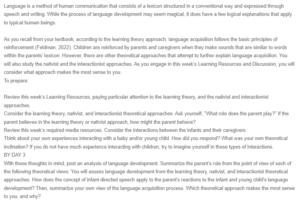Analysis – Language Development
Language development in a young child’s life takes place in immense strides, raising the question of how this takes place. As such, there are a few theories, including the learning theory, nativist theory, and interactionist theoretical theory, that try to answer this question. The first theory, the learning theory, argues that language acquisition in a child results from reinforcement and condition (Feldman, 2012). For example, a child articulating the sound “maa” will receive a positive reaction from the parents because they think the child means to say “mummy”. This reaction will then condition the child to keep repeating these sounds or words. The second theory is the nativist approach, which argues that humans are born with an innate mechanism that enables language development as one matures. Next, the third theory is the interactionist theoretical approach, which combines both factors in the previously stated theories (learning theory and the nativist approach) (Feldman, 2012). Accordingly, this theory argues that genetics and the environment play a role in language development.
Infant-directed speech has a significant role in a child’s language development. Adults tend to alter their speech when talking to infants by using repetition, higher pitch, varied intonation, etc. In that view, newborn children prefer infant-directed speech, meaning they are more receptive to it compared to regular speech. In addition, studies show that children exposed to a lot of infant-directed speech from an early stage seem to start using words as well as exhibiting various forms of linguistic competence at an earlier stage than usual (Feldman, 2012).
After evaluating the three theoretical approaches to language development, the interactionist theoretical approach made the most sense to me. I think that both innate and social factors play key roles in language development in children. Besides, Zuk et al. (2021) found that children born with higher indications of white matter organizations tended to have better linguistic competence. Accordingly, this proves that language development is linked to predisposed innate mechanisms in the brain. On the other hand, a person’s culture and interactions with others bring about the use of language and the development of language skills.
References
Feldman, R. S. (2012). Child development. Pearson Higher Ed.
Zuk, J., Yu, X., Sanfilippo, J., Figuccio, M. J., Dunstan, J., Carruthers, C., & Gaab, N. (2021). White matter in infancy is prospectively associated with language outcomes in kindergarten. Developmental Cognitive Neuroscience, 50, 100973.
ORDER A PLAGIARISM-FREE PAPER HERE
We’ll write everything from scratch
Question

Analysis – Language Development
Language is a method of human communication that consists of a lexicon structured in a conventional way and expressed through speech and writing. While the process of language development may seem magical, it does have a few logical explanations that apply to typical human beings.
As you recall from your textbook, according to the learning theory approach, language acquisition follows the basic principles of reinforcement (Feldman, 2022). Children are reinforced by parents and caregivers when they make sounds that are similar to words within the parents’ lexicon. However, there are other theoretical approaches that attempt to further explain language acquisition. You will also study the nativist and the interactionist approaches. As you engage in this week’s Learning Resources and Discussion, you will consider what approach makes the most sense to you.
To prepare:
Review this week’s Learning Resources, paying particular attention to the learning theory, and the nativist and interactionist approaches.
Consider the learning theory, nativist, and interactionist theoretical approaches. Ask yourself, “What role does the parent play?” If the parent believes in the learning theory or nativist approach, how might the parent behave?
Review this week’s required media resources. Consider the interactions between the infants and their caregivers.
Think about your own experiences interacting with a baby and/or young child. How did you respond? What was your own theoretical inclination? If you do not have much experience interacting with children, try to imagine yourself in these types of interactions.
BY DAY 3
With these thoughts in mind, post an analysis of language development. Summarize the parent’s role from the point of view of each of the following theoretical views: You will assess language development from the learning theory, nativist, and interactionist theoretical approaches. How does the concept of infant-directed speech apply to the parent’s reactions to the infant and young child’s language development? Then, summarize your own view of the language acquisition process. Which theoretical approach makes the most sense to you, and why?

